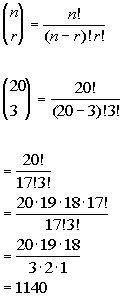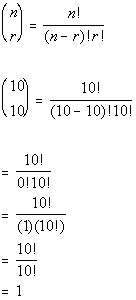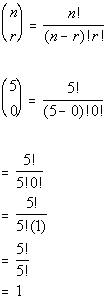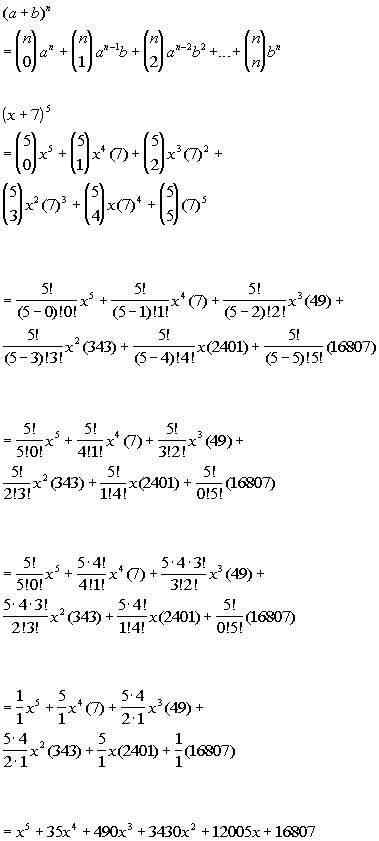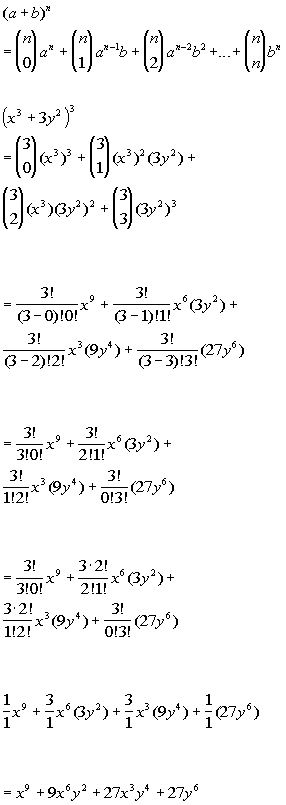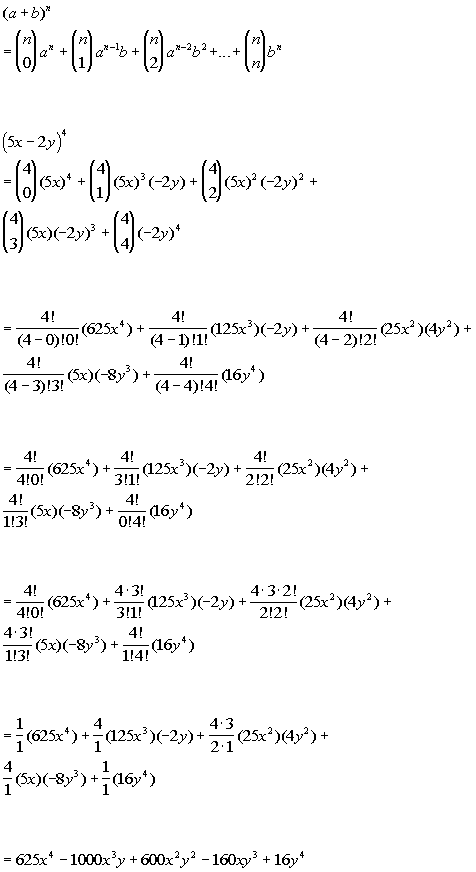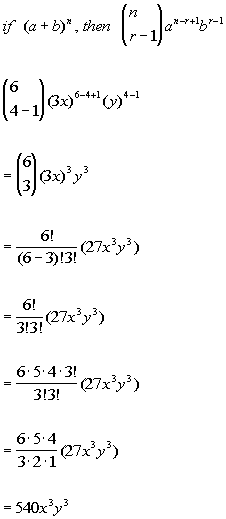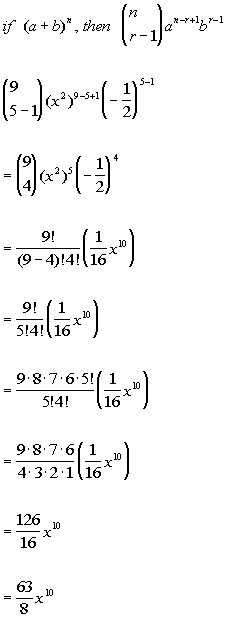Binomial Theorem Class 11 Ncert Solutions in Hindi
College Algebra
Tutorial 54: The Binomial Theorem
![]() Learning Objectives
Learning Objectives
After completing this tutorial, you should be able to:
- Evaluate a factorial.
- Find a binomial coefficient.
- Use the Binomial Theorem to expand a binomial raised to a power.
- Find the rth term of a binomial expansion.
![]() Introduction
Introduction
In this tutorial we will mainly be going over the Binomial Theorem. To get to that point I will first be showing you what a factorial is. This is needed to complete problems in this section. This will lead us into the concept of finding a binomial coefficient, which incorporates factorials into it's formula. From there we will put it together into the Binomial Theorem. This theorem gives us a formula that enables us to find the expansion of a binomial raised to a power, without having to multiply the whole thing out. This theorem incorporates the binomial coefficient formula. You will see that everything in this tutorial intertwines. I think that you are ready to move ahead.
![]() Tutorial
Tutorial
The factorial symbol is the exclamation point: !
So if I wanted to write 7 factorial it would be written as 7!.
In general, n! = n(n - 1)(n - 2)(n - 3)...(1)
Most, (if not all), of you will have a factorial key on your calculator. It looks like this: !
If you have a graphing calculator, it will be hidden under the MATH menu screen and then select your Probability screen - there you should find !
Some calculators don't have one, so I will show you how to simplify the problems in case you don't have that key on your calculator.
0! Has a special definition attached with it. 0! = 1
 Example 1 : Find 7!
Example 1 : Find 7!
If you have a ! key on your calculator you simply press 7 and then ! and in some cases you may have to also press your enter or = key.
If you don't have this key you will have to enter the definition in as follows: 7! = (7)(6)(5)(4)(3)(2)(1) = 5040
Either way 7! = 5040.
We needed to know about factorials because it is used in the formula for binomial coefficients, which is our next topic.
For nonnegative integers n and r, with n > r,
a binomial coefficient is defined by
![]()
This formula can be used to find the coefficient of various terms of a binomial that has been expanded. Believe it or not, it can save you a lot of time if you are needing to know what polynomial you get if you raise a binomial to a large power. It can be very time consuming and cumbersome to multiply out a binomial that is raised to the 6th, 10th, 20th power, etc... This formula is going to lead us into Binomial Theorem which gives us a shortcut way of expanding a binomial.
 Example 2 : Evaluate the binomial coefficient
Example 2 : Evaluate the binomial coefficient![]() .
.
Looks like we are going to need to use the definition of a binomial coefficient to help us out on this.
Looking at the definition of binomial coefficient, what is n ?
If you said 20, you are correct!!! n is the top number, which in this case is 20.
Looking at the definition of binomial coefficient, what is r ?
If you said 3, give yourself a pat on the back!!!! r is the bottom number, which in this case is 3.
Putting those values into the definition of a binomial coefficient we get:
| | *Eval. inside ( ) *Expand 20! until it gets to 17! *Cancel out 17!'s |
If you have a factorial key, you can put it in as 20! divided by 17! divided by 3! and then press enter or =.
If you don't have a factorial key, you can simplify it as shown above and then enter it in. It is probably best to simplify it first, because in some cases the numbers can get rather large, and it would be cumbersome to multiply all those numbers one by one.
The final answer is 1140.
 Example 3 : Evaluate the binomial coefficient
Example 3 : Evaluate the binomial coefficient![]() .
.
Looks like we are going to need to use the definition of a binomial coefficient to help us out on this.
Looking at the definition of binomial coefficient, what is n ?
If you said 10, you are correct!!! n is the top number, which in this case is 10.
Looking at the definition of binomial coefficient, what is r ?
If you said 10, give yourself a pat on the back!!!! r is the bottom number, which in this case is 10.
Putting those values into the definition of a binomial coefficient we get:
| | *Eval. inside ( ) *0! = 1 |
If you have a factorial key, you can put it in as 10! divided by 0! divided by 10! and then press enter or =.
If you don't have a factorial key, you can simplify it as shown above and then enter it in. It is probably best to simplify it first, because in some cases the numbers can get rather large, and it would be cumbersome to multiply all those numbers one by one.
The final answer is 1.
 Example 4 : Evaluate the binomial coefficient
Example 4 : Evaluate the binomial coefficient![]() .
.
Looks like we are going to need to use the definition of a binomial coefficient to help us out on this.
Looking at the definition of binomial coefficient, what is n ?
If you said 5, you are correct!!! n is the top number, which in this case is 5.
Looking at the definition of binomial coefficient, what is r ?
If you said 0, give yourself a pat on the back!!!! r is the bottom number, which in this case is 0.
Putting those values into the definition of a binomial coefficient we get:
| | *Eval. inside ( ) *0! = 1 |
If you have a factorial key, you can put it in as 5! divided by 5! divided by 0! and then press enter or =.
If you don't have a factorial key, you can simplify it as shown above and then enter it in. It is probably best to simplify it first, because in some cases the numbers can get rather large, and it would be cumbersome to multiply all those numbers one by one.
The final answer is 1.
For any positive integer n:
![]()
Some things to note about this theorem:
The top number of the binomial coefficient is always n , which is the exponent on your binomial.
The bottom number of the binomial coefficient starts with 0 and goes up 1 each time until you reach n , which is the exponent on your binomial.
The 1st term of the expansion has a (first term of the binomial) raised to the n power, which is the exponent on your binomial. From there a 's exponent goes down 1, until the last term, where it is being raised to the 0 power; which is why you don't see it written.
The first term of the expansion has b (second term of the binomial) raised to the 0 power, which is why you don't see it written. From there b 's exponent goes up 1, until the last term, where it is being raised to the n th power, which is the exponent on your binomial.
 Example 5 : Use the Binomial Theorem to expand the binomial
Example 5 : Use the Binomial Theorem to expand the binomial![]() . Simplify the result.
. Simplify the result.
Looks like we are going to need to use the Binomial Theorem to help us out on this.
Looking at the Binomial Theorem, what is a ?
If you said x , you are correct!!! a is the first term of the binomial, which in this case is x .
Looking at the Binomial Theorem, what is b ?
If you said 7, give yourself a pat on the back!!!! b is the second term of the binomial, which in this case is 7.
Looking at the Binomial Theorem, what is n ?
If you said 5, give yourself a high five!!!! n is the exponent on the binomial, which in this case is 5.
Putting those values into the Binomial Theorem we get:
| | *Use definition of *Eval. 7's raised to exponents *Expand num. until it gets to |
If you have a factorial key, you can put in the binomial coefficient part of each term as the (top number)! divided by the (first number in the denominator) ! divided by the (second number in the denominator)! and then press enter or =.
If you don't have a factorial key, you can simplify it as shown above and then enter it in. It is probably best to simplify it first, because in some cases the numbers can get rather large, and it would be cumbersome to multiply all those numbers one by one.
So our final answer is![]() .
.
 Example 6 : Use the Binomial Theorem to expand the binomial
Example 6 : Use the Binomial Theorem to expand the binomial![]() . Simplify the result.
. Simplify the result.
Looks like we are going to need to use the Binomial Theorem to help us out on this.
Looking at the Binomial Theorem, what is a ?
If you said![]() , you are correct!!! a is the first term of the binomial, which in this case is
, you are correct!!! a is the first term of the binomial, which in this case is![]() .
.
Looking at the Binomial Theorem, what is b ?
If you said![]() , give yourself a pat on the back!!!! b is the second term of the binomial, which in this case is
, give yourself a pat on the back!!!! b is the second term of the binomial, which in this case is![]() .
.
Looking at the Binomial Theorem, what is n ?
If you said 3, give yourself a high five!!!! n is the exponent on the binomial, which in this case is 3.
Putting those values into the Binomial Theorem we get:
| | * a = x ^3, b = 3 y ^2, n = 3 *Use definition of binomial coefficient *Eval. x ^3's and 3 y ^2's raised to exponents *Expand num. until it gets to larger ! in the den. *Simplify |
If you have a factorial key, you can put in the binomial coefficient part of each term as the (top number)! divided by the (first number in the denominator) ! divided by the (second number in the denominator)! and then press enter or =.
If you don't have a factorial key, you can simplify it as shown above and then enter it in. It is probably best to simplify it first, because in some cases the numbers can get rather large, and it would be cumbersome to multiply all those numbers one by one.
So our final answer is![]() .
.
 Example 7 : Use the Binomial Theorem to expand the binomial
Example 7 : Use the Binomial Theorem to expand the binomial![]() . Simplify the result.
. Simplify the result.
Looks like we are going to need to use the Binomial Theorem to help us out on this.
Looking at the Binomial Theorem, what is a ?
If you said 5 x , you are correct!!! a is the first term of the binomial, which in this case is 5 x .
Looking at the Binomial Theorem, what is b ?
If you said -2 y , give yourself a pat on the back!!!! b is the second term of the binomial, which in this case is -2 y .
Be careful here. The way the Binomial Theorem is written, whatever sign is in front of b is part of b 's value. Since there was a - in front of 2 y , b 's value includes the -.
Looking at the Binomial Theorem, what is n ?
If you said 4, give yourself a high five!!!! n is the exponent on the binomial, which in this case is 4.
Putting those values into the Binomial Theorem we get:
| | *Use definition of *Eval. 5 x 's and -2 y' s raised to exponents *Expand num. until it gets to *Simplify |
If you have a factorial key, you can put in the binomial coefficient part of each term as the (top number)! divided by the (first number in the denominator) ! divided by the (second number in the denominator)! and then press enter or =.
If you don't have a factorial key, you can simplify it as shown above and then enter it in. It is probably best to simplify it first, because in some cases the numbers can get rather large, and it would be cumbersome to multiply all those numbers one by one.
So our final answer is![]() .
.
The rth term of the expansion of![]() is
is
![]()
Some things to note about the r th term:
The top number of the binomial coefficient is n , which is the exponent on your binomial.
The bottom number of the binomial coefficient is r - 1, where r is the term number.
a is the first term of the binomial and its exponent is n - r + 1, where n is the exponent on the binomial and r is the term number.
b is the second term of the binomial and its exponent is r - 1, where r is the term number.
 Example 8 : Find the fourth term of the expansion
Example 8 : Find the fourth term of the expansion![]() . Simplify the result.
. Simplify the result.
Looks like we are going to need to use the r th term expansion formula to help us out on this.
Looking at the r th term expansion formula, what is n ?
If you said 6, you are correct!!! n is the exponent on your binomial, which in this case is 6.
Looking at the r th term expansion formula, what is r ?
If you said 4, give your self a pat on the back!!!! r is the number of the term to be found, which in this case is 4.
Looking at the r th term expansion formula, what is a ?
If you said 3 x , you are correct!!! a is the first term of the binomial, which in this case is 3 x .
Looking at the r th term expansion formula, what is b ?
If you said y , give yourself a pat on the back!!!! b is the second term of the binomial, which in this case is y .
Putting those values into the r th term expansion formula we get:
| | * n = 6, r = 4, a = 3 x , b = y *Use definition of binomial coefficient *Eval. inside ( ) *Expand 6! until it gets to 3! *Cancel out !'s *Simplify |
If you have a factorial key, you can put the binomial coefficient in as 6! divided by 3! divided by 3! and then press enter or =.
If you don't have a factorial key, you can simplify it as shown above and then enter it in. It is probably best to simplify it first, because in some cases the numbers can get rather large, and it would be cumbersome to multiply all those numbers one by one.
This would tell us that the 4th term of the binomial![]() would be
would be![]() .
.
 Example 9 : Find the fifth term of the expansion
Example 9 : Find the fifth term of the expansion![]() . Simplify the result.
. Simplify the result.
Looks like we are going to need to use the r th term expansion formula to help us out on this.
Looking at the r th term expansion formula, what is n ?
If you said 9, you are correct!!! n is the exponent on your binomial, which in this case is 9.
Looking at the r th term expansion formula, what is r ?
If you said 5, give your self a pat on the back!!!! r is the number of the term to be found, which in this case is 5.
Looking at the r th term expansion formula, what is a ?
If you said![]() , you are correct!!! a is the first term of the binomial, which in this case is
, you are correct!!! a is the first term of the binomial, which in this case is![]() .
.
Looking at the r th term expansion formula, what is b ?
If you said -1/2, give yourself a pat on the back!!!! b is the second term of the binomial, which in this case is -1/2.
Be careful here. The way the formula for the rth term of a binomial expansion is written, whatever sign is in front of b is part of b 's value. Since there was a - in front of 1/2, b 's value includes the -.
Putting those values into the r th term expansion formula we get:
| | * n = 9, r = 5, a = x ^2, b = -1/2 *Use definition of binomial coefficient *Eval. inside ( ) *Expand 9! until it gets to 5! *Simplify |
If you have a factorial key, you can put the binomial coefficient in as 9! divided by 5! divided by 4! and then press enter or =.
If you don't have a factorial key, you can simplify it as shown above and then enter it in. It is probably best to simplify it first, because in some cases the numbers can get rather large, and it would be cumbersome to multiply all those numbers one by one.
This would tell us that the 5th term of the binomial![]() would be
would be![]() .
.
![]() Practice Problems
Practice Problems
These are practice problems to help bring you to the next level. It will allow you to check and see if you have an understanding of these types of problems. Math works just like anything else, if you want to get good at it, then you need to practice it. Even the best athletes and musicians had help along the way and lots of practice, practice, practice, to get good at their sport or instrument. In fact there is no such thing as too much practice.
To get the most out of these, you should work the problem out on your own and then check your answer by clicking on the link for the answer/discussion for that problem. At the link you will find the answer as well as any steps that went into finding that answer.
Practice Problems 1a - 1b: Evaluate the binomial coefficient.
Practice Problems 2a - 2b: Use the Binomial Theorem to expand the binomial. Simplify the results.
Practice Problems 3a - 3b: Find the given term of the expansion. Simplify the results.
Need Extra Help on these Topics?

Last revised on May 19, 2011 by Kim Seward.
All contents copyright (C) 2002 - 2011, WTAMU and Kim Seward. All rights reserved.
Binomial Theorem Class 11 Ncert Solutions in Hindi
Source: https://www.wtamu.edu/academic/anns/mps/math/mathlab/col_algebra/col_alg_tut54_bi_theor.htm
